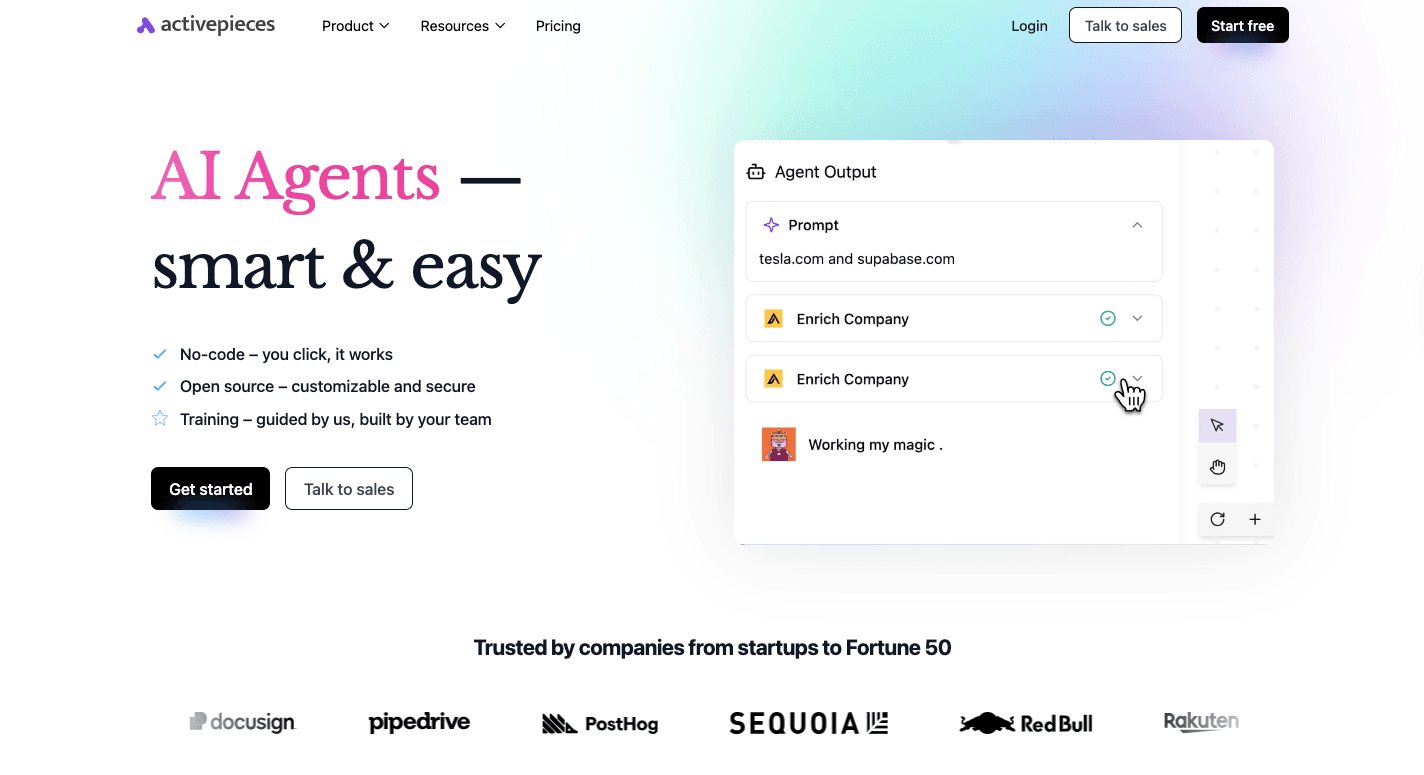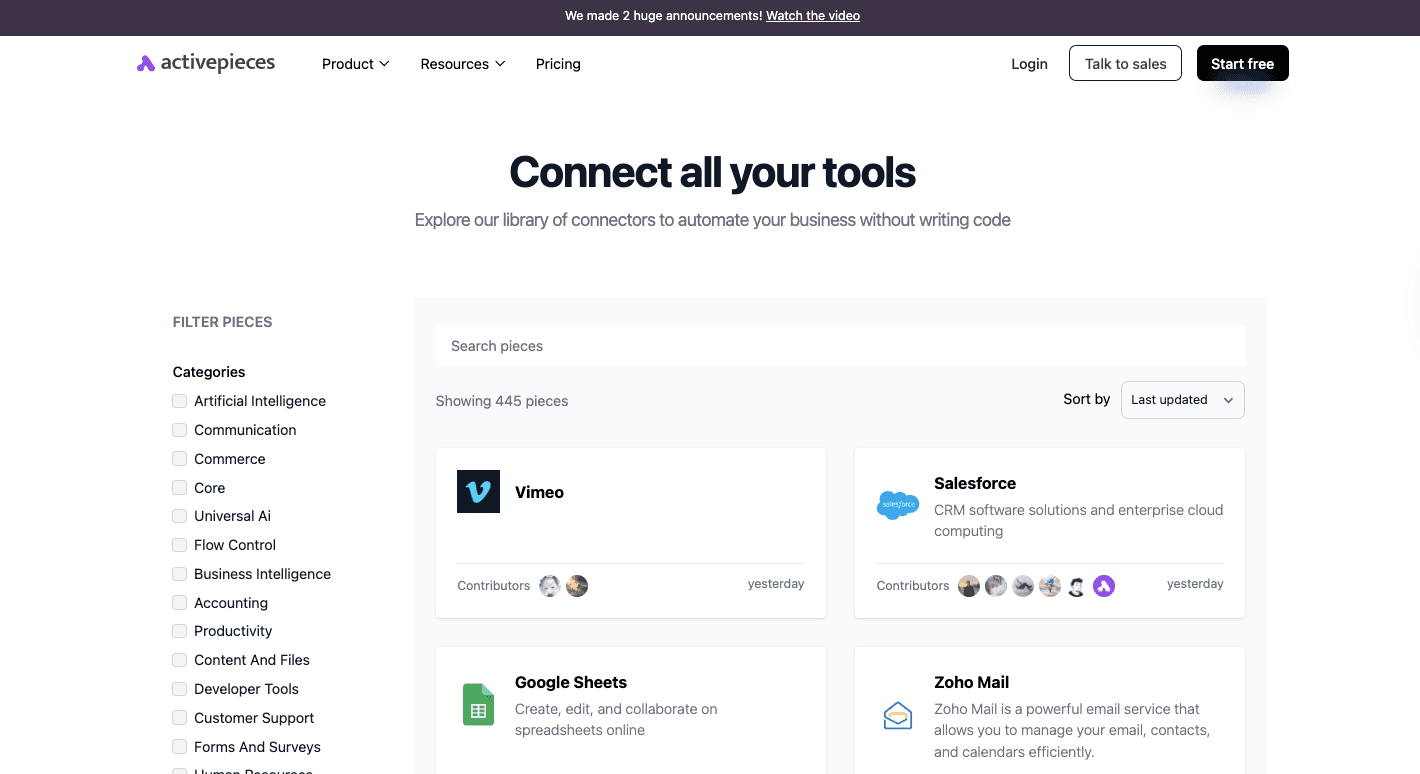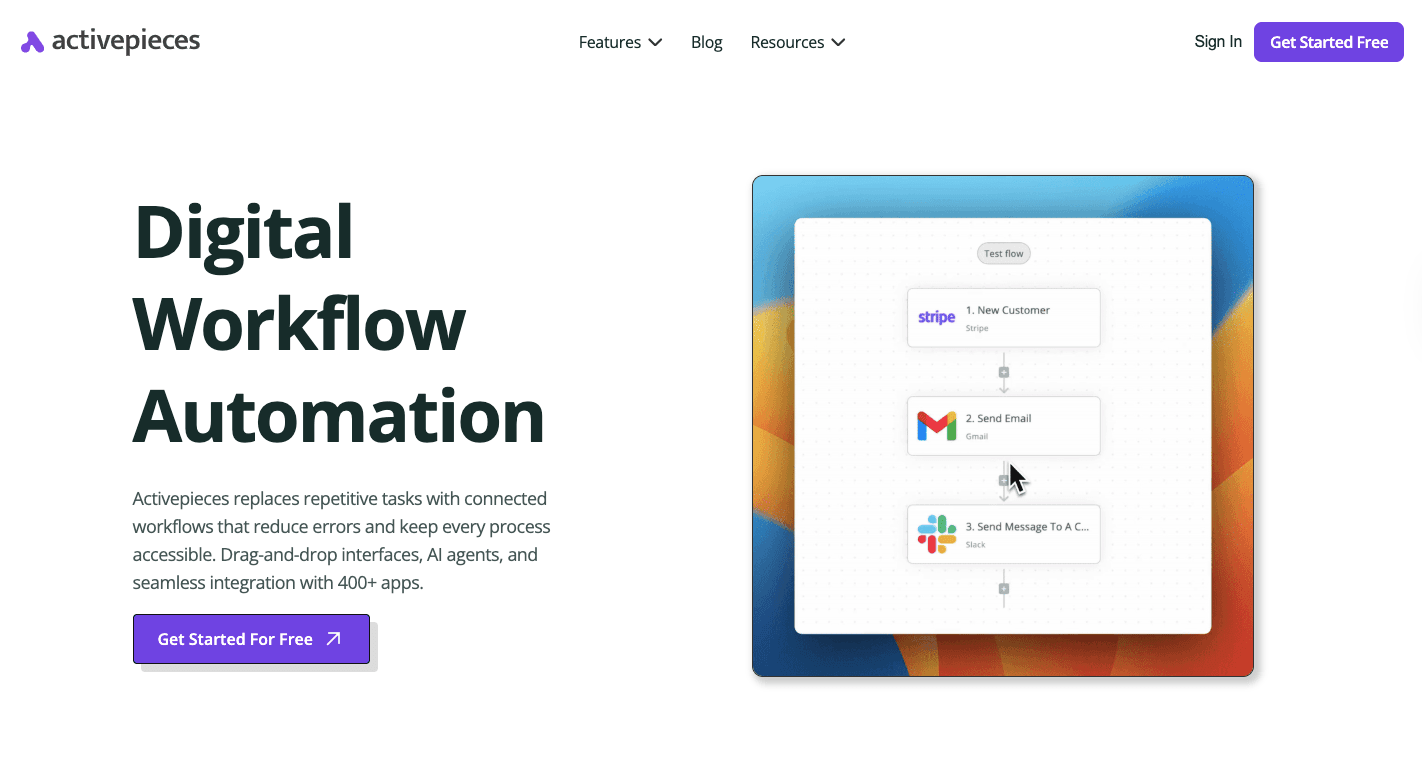What Is Content Automation? A Simple Guide for Marketers

Creating content today takes more than writing a few posts and hitting publish. You handle blogs, emails, and social media posts as you keep your brand voice consistent and your deadlines on track.
There's no need to keep doing that anymore. Many businesses now use content automation tools to connect every step of the content creation process into one smooth system. This kind of content workflow management helps you cut errors, save time, and boost your campaigns across platforms.
In this article, you'll learn how content automation works and how it improves efficiency for digital marketers.
Try it for free and discover how Activepieces simplifies content automation!
What Is Content Automation?
Content automation uses artificial intelligence (AI) and software to connect every stage of the content lifecycle into a coordinated process.
Manual content creation is time-consuming, often requiring you to repeat the same actions for different campaigns or formats. Automation handles these repetitive tasks, and in turn, saves you hours each week for performance improvement.
Humans still guide the business process by:
- Setting brand guidelines
- Defining templates
- Connecting CRM systems or analytics dashboards
These elements teach automation how to operate within your brand's standards.
AI-powered systems then use extensions of semantic analysis and natural language processing (NLP) to generate drafts and personalized content for different audience segments. Visual content automation adds design elements that match each channel's tone and layout.
Later, human editors review and refine outputs to maintain brand consistency and make sure every asset meets quality goals. Implementing automation in this way allows you to improve content quality and deliver unified campaigns that connect your brands with real people.
The Core Process Behind Automated Content Creation
Automation makes the content creation process faster. Each stage connects smoothly, so you can create and share content without losing time or quality.
Define and Strategize
Before anything runs automatically, someone needs to map out what the system should actually do. That means setting goals, deciding which platforms matter, and figuring out how automation fits into your larger content strategy.
It helps to know exactly who the content is for. You break down specific audience segments. Those insights shape how AI should write, format, and prioritize each piece.
Input Data and Prompts
Once the plan is in place, it needs to be translated into instructions that the software can follow. Every prompt tells the system what to make, how it should sound, and who it's meant to reach.
To help the AI stay aligned with your previous work, you feed in data:
- Keywords
- Tone
- Structure
- References from existing content
You can also add details like audience preferences or customer data, which makes personalized content possible. Connecting automation tools to CRMs or analytics platforms further gives the system enough context to write for intent, not just volume.
Research and Ideation
During research and ideation, you use automation to scan search data, trending topics, and audience behavior to generate content ideas that people actually care about.
That analysis goes far beyond surface-level topics. Systems track conversations, competitor coverage, and keyword patterns to show where new opportunities exist. You can spot what's missing in your field and plan content that fills those gaps.
Refinement and Optimization
After drafts are generated, automation doesn't stop. The refinement and optimization phase fine-tunes the structure and keeps your messages aligned with search intent. AI checks grammar, sentence flow, and meta descriptions, and flags weak sections before publishing.
Systems can also work with existing content, improving or reshaping it for new platforms. That includes:
- Adjusting visuals
- Pulling quotes for social snippets
- Adapting long articles into shorter formats
Editors still make the final call, though. They read for logic, flow, and accuracy, correcting what algorithms can't. The mix of automation and human review keeps quality high and the message consistent, no matter how much content you produce.
Human Review and Editing
The review stage focuses on accuracy, depth, and emotional tone. Editors fact-check every statement, verify statistics, and remove phrases that sound generic or off-brand.
Quality control happens here, too. AI sometimes creates confident but inaccurate claims, or what specialists call "hallucinations."
Your editors also catch subtle bias, filler sentences, or borrowed phrasing that could create legal or ethical issues later. The process turns a technically correct draft into content that feels credible and authoritative.
Editors add creativity and perspective that no model can replicate. They adjust rhythm and tone, weave in real examples, and connect the message to what audiences actually care about.
Publish and Distribute
Once editors approve the final draft, automation takes over again. Publishing systems post across websites, email lists, and social platforms without manual uploading. That process is known as "distributing content," and it's one of automation's biggest time-savers.
Tools handle scheduling, formatting, and platform-specific tweaks. The same post can appear on:
- A company blog
- An email newsletter
Campaigns that include paid advertising campaigns or promoted posts also use these systems to manage budgets and timing automatically.
Performance Tracking and Analysis
Each post, email, or ad creates data that helps you understand what's working. Automated analytics tools collect metrics like traffic, conversions, and engagement rates. Those numbers reveal patterns in user engagement, such as what people read and which topics convert best.
AI systems use data analysis to highlight trends humans might miss. They group performance by format, timing, and audience behavior to show which messages resonate with each segment.
This constant feedback improves both automation and human decision-making. Over time, each cycle teaches the system what succeeds and what needs refining.
The Benefits of Implementing Automation in Your Content Creation Process
Automated workflows limit human effort in repetitive tasks, cut production delays, and reduce errors. These systems further streamline content creation, maintain quality, and grow without stretching their resources.
Besides that, it:
- Increases overall content production without needing larger teams
- Reduces manual work by automating scheduling, formatting, and publishing
- Improves efficiency by cutting approval and delivery times
- Supports smarter marketing efforts through connected tools and shared data
- Helps maintain consistency in tone, visuals, and brand messaging
- Lowers costs by minimizing rework and editing time
- Enhances quality with built-in proofreading and SEO checks
- Keeps campaigns aligned across departments and channels
- Delivers measurable insights that guide better decisions
How Marketers Use Content Automation
Marketers typically use content automation in:
Automating Blog Creation
Blog automation allows you to create content without manual effort using AI tools. Once reviewed, editors polish the AI-generated content to keep tone consistent and ideas fresh.
Connecting automation to analytics or CRM data makes it easy to create personalized content for readers. For example, product recommendations, tone, or examples can shift based on audience interests.
Over time, automation learns from engagement data and builds a steady rhythm for new posts.
Want to automate your blog writing with AI? Check out our step-by-step guide on how to do it using OpenAI and discover how Activepieces can assist: Automate Blog Writing with AI: A Step-by-Step Guide using OpenAI · Activepieces
Social Media Automation
Automation schedules social media posts, analyzes performance, and even generates captions or content templates. You can even build multiple versions of one message to test headlines and visuals that best reach your target audience.
Platforms now support:
- Video content
- Quotes
- Polls
- Social media graphics
Drafting tools can suggest social media captions to match tone and timing, too.
Email Marketing Automation
Email automation workflows trigger messages based on user actions. These systems form the core of content marketing automation, which manages everything from A/B tests to follow-up timing.
Each automated content marketing campaign uses customer data to personalize messages, product suggestions, and timing automatically. The same data also drives digital advertising, so you can retarget across channels with the same consistent message.
You just design sequences once and let automation adjust details based on audience behavior. It keeps outreach steady and saves time.
SEO Optimization and Reporting
SEO automation helps you stay consistent without spending hours tracking metrics. AI systems scan content, suggest fixes, and optimize your content for search engines by optimizing:
- Headers
- Links
- Meta descriptions
These systems also perform keyword research to uncover new ranking opportunities before competitors do. When traffic dips, you can see what has changed and act quickly.
Common Types of Content Automation Tools
The common types of automated content creation tools you can use include:
Workflow Automation Platforms
Workflow automation platforms connect apps, trigger actions, and manage progress from start to finish without constant supervision. These platforms work through simple "if this, then that" rules.
Other than that, these tools also sync tools like writing assistants, analytics dashboards, and content management systems (CMS), to keep everything in one loop.
Selecting the right tools will help you combine automation with transparency. You can save hours that would've been spent switching between apps or sending reminders.
Start Creating High-Quality Content Automation With Activepieces

Activepieces is an open-source automation platform for people who want real control over their workflows. It connects hundreds of tools into one system that runs across multiple platforms, so you can automate everything in a single place.
The platform adjusts easily to your existing system and fits naturally into your daily tools. Since it's open source, you can host it yourself for full control or use the cloud version for convenience.
These content automation capabilities are the basis that helps your business move faster and stay consistent without depending on multiple disconnected systems.
Features
These features make Activepieces a platform that grows with you:
- Open source framework - Anyone can self-host, modify, or extend Activepieces freely.
- AI-ready automations - Use AI to write, summarize, and analyze data directly inside workflows.
- No-code flow builder - Build flows visually, connect apps, and deploy automations quickly.
- Enterprise security - Self-host or use private networks for complete data control.
- Human review steps - Add pauses for approvals before a flow continues.
- Developer tools - All pieces are written in TypeScript, so developers can customize and test instantly with hot reload.
Use Cases
Activepieces works for almost every modern team because it connects creative work, operations, and analytics in one automated process.
Marketing teams can use it to schedule content, automate reports, and send personalized messages at scale. Operations teams can connect CRMs, support tools, and email platforms to keep customer data synced automatically.
Meanwhile, developers can build custom flows that connect APIs or add human review checkpoints before an automation continues.
Some include:
- Automating blog or social content publishing
- Routing leads from forms directly into your CRM
- Using AI to summarize customer feedback
- Sending alerts when performance data changes
For example, Activepieces can be connected to ChatGPT to automate the creation of long-form blog posts (1,500+ words), which makes content generation faster and more efficient.
You can use a pre-built automation flow in Activepieces to trigger the process whenever a new blog title is added to a Google Sheet. The flow first asks ChatGPT to generate an outline of the article, then iterates through each heading to produce detailed sections.
It compiles the content into a full blog post and automatically publishes it on your WordPress site, while optionally sending an email notification for review.
Integrations
Right now, Activepieces connects with 445 pre-built integrations (called "pieces"), and that number keeps growing. These pieces link tools across marketing, analytics, communication, and finance inside one system.

Some of the current data integrations include:
- OpenAI
- Google Sheets
- ElevenLabs
- WordPress
- ActiveCampaign
- Total CMS
- Slack
- ClickUp
- Zoho CRM
- Microsoft Excel 365
- Dynamics CRM
Because the platform is community-driven, developers can build and share new pieces at any time. That constant growth means Activepieces keeps expanding its reach, staying one of the most connected automation platforms available today.
Speak with our sales team today and see how to automate at scale!
AI Content Generation Tools
AI content generation systems can write copy, suggest topics, or design visuals using models trained on billions of data points. An AI image generation tool, such as Midjourney, can build branded materials in seconds that match tone and format.
All content generated by AI stays aligned with your style guide and messaging, and requires only minimal human input for review. Many marketers further use AI to personalize posts, repurpose blogs, or draft outlines.
Publishing and Distribution Tools
Publishing and distribution platforms take finished content and deliver it everywhere it needs to go. They connect directly with content management systems like WordPress or HubSpot to schedule and post updates across blogs, newsletters, and social channels automatically.
These tools analyze engagement data to pick the best posting times and formats for each audience. Consistent posting builds trust, keeps messaging uniform, and helps content reach the right people at the right time.
Simplify Automated Content Generation for Digital Marketers With Activepieces

Activepieces makes automated content generation easy for digital marketers who want to get more done with less setup. It connects the apps you already use and turns them into a unified system.
With 445 built-in pieces currently available and the freedom to build your own, Activepieces brings flexibility and control that most automation platforms don't offer.
Then, the visual builder lets you create workflows without code, while developers get full customization using TypeScript. So if you're automating blog content, syncing leads, or running reports, Activepieces adapts to your workflow rather than forcing you to change it.
You can even set up AI-powered content flows that research topics, generate copy, and push posts live across multiple channels.
Compared to other platforms, Activepieces offers you automation without limits.
Create your free Activepieces account and start saving hours every week!
FAQs About What is Content Automation
What is an example of content automation?
An example of content automation is using AI tools to automatically create and schedule blog posts, Google Ads, and marketing materials. The system organizes and distributes relevant content across multiple channels, while automation handles repetitive tasks like formatting or posting updates.
It helps guide your content automation efforts and keeps a consistent brand voice across every platform without sacrificing quality or accuracy.
What is automation content?
Automation content refers to digital assets, like blogs, ads, or emails, produced or managed by automated systems.
These tools generate, optimize, and distribute material that matches your goals and brand tone. It doesn't replace human creativity, but it speeds up production and keeps messaging consistent across campaigns.
Does content automation work?
Yes. Content automation works when supported by a solid strategy and clear human direction. It saves time, increases output, and helps teams stay consistent. When used correctly, it automates the manual parts of content creation while maintaining creative control.
What is an example of automation?
An example of automation is setting up a workflow where an email campaign sends new blog updates to subscribers automatically. The system handles the setup and delivery, which saves you time and reduces manual input.


